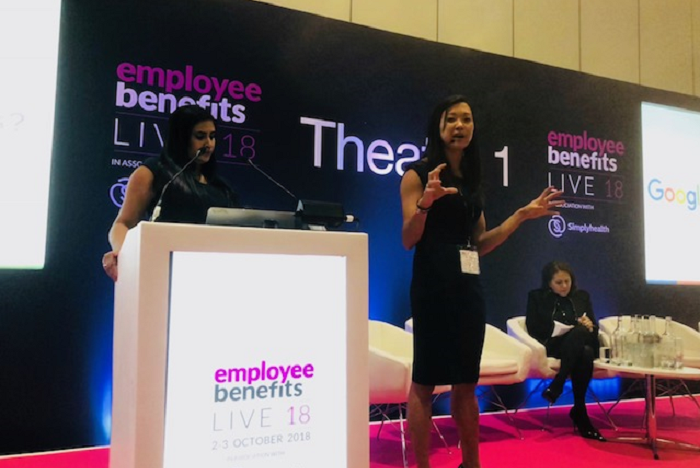
Employee Benefits Live 2018: Technology organisation Google uses industry data and employee feedback to help inform its approach to mental health supports, and ensure its health and wellbeing provision is tailored to employee need.
In the opening keynote address at Employee Benefits Live 2018, titled ‘Putting health and wellbeing at the heart of your benefits strategy’, Cayla Kitayama (pictured, centre), Europe, Middle East and Africa (EMEA) benefits at Google, said: “It comes down to data, data, data. This is the backbone to all of our policies and all of our programmes.”
This takes the form of a three-pronged approach: understanding the legal requirements of what the organisation needs to provide, being aware of local provisions and available state support in different global jurisdictions and also considering what Google’s peers offer to align with industry norms.
This data collection is supported by an annual, all-employee survey across Google’s 52,000 staff; this typically receives a 96% response rate and forms the basis for changes Google decides to implement. “We have seen actual changes in our [organisation] based off of this feedback,” Kitayama added.
In addition, every two years Google undertakes its people health survey; this specifically focuses on benefits and mental health.
Off the back of this data collection and benchmarking, Google has been able to implement an array of programmes in order to support employees’ mental health and wellbeing. According to Kitayama, the organisation’s most valued and popular benefit in this space is its life insurance policy, which offers UK-based employees a core minimum of four times base salary. If an employee has a family, this increases to seven times base salary, plus an extra £150,000 payment.
Initiatives that Google has introduced to support employees’ mental wellbeing include a digital sleep improvement programme, which has seen employees increase the amount of sleep they have by 3.5 hours a week, mindfulness sessions, offering flexible working hours, a second medical opinion benefit that includes access to a critical psychiatrist, a massage programme, which enables employees to receive an hour-long massage for a subsidised price of £15, free food and thoughtfully created workspaces.
The organisation also uses a variety of peer support network groups, such as the self-initiated mental health group; members of this network wear a blue pin badge to highlight to other employees that they can talk to them privately if they have any mental health issues, worries or concerns.
For Kitayama, providing benefits, information and resources that are easy to access is vital, too. “Online resources, just having things accessible so people can find information as they need. What we found a couple of years ago is that we have all these great resources, but they live all over inter-webs, so what our team had to do, is we actually had a look internally and go ‘right, we need to collect all this, package it up, make it easy to find for people’.” Kitayama linked this to embracing a multi-channel communications and delivery approach, advocating both face-to-face and digital options. For example, employees were not utilising an on-site GP and nurse benefit when they had to call to make appointments, but moving to an online booking system saw sessions promptly become fully booked.
Flexible working is another piece of Google’s cultural jigsaw puzzle, which contributes to improving employees’ mental wellbeing. This typically takes the form of different working hours, reduced hours or job shares, where two employees will share the same job and work around 60% of the role each. Although Kitayama admitted that this may not be suitable for all positions within the organisation, Google strives to find a position or a team that is right for each individual.
Google has also increased its different leave arrangements, primarily its baby bonding leave. This enables non-birth parents to take up to 12 weeks of leave at full pay. “This is our global minimum,” Kitayama explained. “This is for any non-birth parent, it’s 12 weeks, fully paid, on bonus. Worldwide. We found that this helps new parents, whether it’s your birth child or not.”
Addressing health and wellbeing within the workplace does have its challenges, however; most notably for Google, being able to scale and grow programmes in alignment with business growth and expansion around the world. “Globalisation and scale: this is a really big one for us. We keep expanding and so it’s taking these programmes and how do we create it globally and consistently? Now that our [organisation] keeps growing, how do we create programmes that are going to grow with us?” Kitayama said.
Further challenges include creating the right culture to accommodate non-binary options and different ethnicities, being able to benchmark data efficiently, completing onboarding processes in a timely fashion through legal and organisational requirements and finding the balance between employee and employer expectations.
Kitayama clearly outlined the business case for supporting mental wellbeing; it impacts upon productivity, physical health, relationships, quality of work and business costs, if employers consider absenteeism and healthcare claims. Although both employees’ personal and professional lives can affect their mental health, Kitayama advised that organisations should look to build awareness and train managers to spot the signs of mental ill health. Managers should also be equipped with the necessary tools, information and resources they need to support staff who may be struggling with mental health issues.
Kitayama also stated that employers have a role to play in destigmatising mental health discussions in the workplace, placing particular emphasis on the role of senior managers and leaders who need to lead by example. “This is very much a top-down approach,” she explained. “It’s about leaders who are sharing their stories, about taking breaks, using their vacation, showing flexible working.”